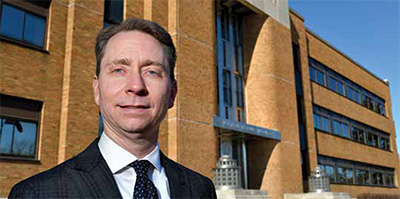Hardly a season goes by when we don’t hear of some new kid on the block of central Illinois’ high-tech start-up scene. It can be hard to keep up.
That’s great news for the local economy, all of that energy and invention and excitement being spread around, but it also can make it easy to overlook the granddaddy of them all. Indeed, still sitting at the head of the local Innovation family table is the National Center for Agricultural Utilization Research (NCAUR) – aka the “Ag Lab” – which has filled more than 300,000 square feet of an art deco building on the corner of Peoria’s University and Nebraska Avenue since the Great Depression.

Overlooking Interstate 74, the building at 1815 N. University and its occupant are no doubt a mystery to many a motorist driving by. Yet NCAUR has made legitimately global headlines over the decades.
Its discovery regarding the mass production of penicillin in the mid-1940s would win the Lasker Award – “America’s Nobel” — for its creators, while more importantly saving countless lives following its introduction just in time for World War II’s D-Day invasion. That breakthrough would usher in the era of antibiotics to treat otherwise deadly infection.
Its scientists – nearly 90 of them still toiling away among a total workforce of approximately 250 — didn’t rest on those laurels, following up with technologies that revolutionized the way we live our daily lives, from Dextrose to Xanthan Gum, from Super Slurper to Oatrim.
Today, the place seemingly plugs along without much fanfare, going about its business, flying below the radar. Don’t be fooled.
“There’s a lot” going on at the Ag Lab now, says Dr. Todd Ward, its director for the last two years, before punctuating it with yet one more, “There’s a lot.”

Indeed, “biobased” may be the buzzword of the moment, but it never really left the Ag Lab’s mission statement, taking the crops grown year after year after year in the fertile fields surrounding the city – corn, soybeans, wheat, sorghum, barley, you name it – and converting them “into something of higher value,” said Ward. From chemicals to enzymes, polymers to biofuels, today the emphasis is on creating natural, plant-based alternatives to environmentally unfriendly products such as plastic and petroleum-based fuels.
Meanwhile, the Lab’s largest research unit is devoted to food security and public health, addressing crop pests and diseases, insect vectors such as mosquitoes and ticks, and more, the aim being to protect people and animals from naturally occurring toxins and other threats.
Great progress has been in the alternative fuels market, from the use of high oleic acid soy oil to power jets to biobutanol from sweet sorghum for your SUV.
There is promising research on hemp and the oils it produces, forbidden but just a few years ago.
Over the last five years, NCAUR has added global warming to its vast and growing portfolio, with those climate concerns elevating the urgency to find new ways to enhance the resilience of crops to rising temperatures and CO2, said Ward.

The Lab just got word that it will be getting a $4.5 million grant, requested by Congresswoman Cheri Bustos and Congressman Darin LaHood in the fiscal year 2022 budget, that would go toward construction of a new greenhouse to aid in the study of climate change and its effects. Ward calls it “absolutely vital to expanding our programs in climate resilience architecture.”
All in all, the work coming out of NCAUR has formed the foundation for the rise of multiple billion-dollar industries. This new frontier looks just as promising, with more than 60 commercial licenses currently granted to private sector companies hoping to take NCAUR’s research to market.
Among the furthest along locally is Midwest Bioprocessing Center, housed at the Peoria NEXT Innovation Center.
Ag Lab representatives “were a cornerstone of the initial Peoria NEXT steering committee looking to foster inter-institutional collaborative research as an economic development tool,” said Michael Stubbs, director of Peoria NEXT.
Their work with Midwest Bioprocessing Center is a great example of that. The two are partnering on the use of hemp seed oil in skin care products. Another is the development of the cover crop pennycress into a commercial biofuel, said Stubbs.
Vivian Standifird, executive director of Peoria Bio-Made, has become a fan, as well. NCAUR “is a tremendous asset for the biotech industry,” she said. “Peoria is truly fortunate to have such a level of expertise, found in few places in the world.”
All of that is music to the ears of local economic development professionals. Indeed, it has been a decades-long rustration that because R&D follows venture capital, the jobs that otherwise might have been created here have too often escaped to both coasts, where most of that capital seems to exist.
That is starting to change. Communication channels that once upon a time may not have even existed locally have been opened.

“We need to get in touch with them and they need to get in touch with us,” Ward said of local entrepreneurs. COVID made some of that outreach more difficult the last couple of years, but NCAUR’s director has made it a priority. Meanwhile, the Ag Lab’s Technology Transfer Office is located right here “to help more of these technologies stick here in Peoria,” he said.
“I think the Ag Lab can be a selling point for that,” added Ward. “We do a lot of listening to stakeholders about what type of research projects we want to undertake.”
The Ag Lab is a public agency, of course, and its annual budget from the federal government tops $30 million. That said, as recently as 2016, NCAUR was targeted by Capitol Hill for possible closure, until the state’s political representatives and private sector stakeholders went to bat for it.
“Absolutely,” it’s important to have this kind of operation in a place like Peoria, said Ward. “Being in the heart of a huge farm state like Illinois gives us a lot of advantages.”
Meanwhile, it’s all but impossible to walk away from the facility’s fantastic history, which can’t help but inspire the people who work there now. Seven of its scientists – Kerry O’Donnell, Cletus Kurtzman, Edward Bagley, George Inglett, Allene Jeanes, Herbert Dutton and William Doane – have been inducted into the Agricultural Research Service Hall of Fame. Andrew J. Moyer, the microbiologist behind the penicillin breakthrough, is a member of the National Inventors Hall of Fame.
By the way, did we mention that NCAUR brags one of the world’s largest publicly available collections of microorganisms, approximately 98,000 isolates of bacteria and fungi? Don’t be making fun of fungus. It was melon mold, after all — on a cantaloupe, in fact — that ultimately led to the lab’s penicillin discovery, and there are countless people who are alive today because of it. Those microbe strains are shared with nations around the world.

“It’s really there because of Ev Dirksen,” former U.S. Transportation Secretary and Congressman Ray LaHood said of the famously gravel-voiced representative and senator who championed construction of a new Ag Lab back when there was nothing but Bradley University and a lot of cornfields in that part of town.
That legislative commitment to the lab continued under Bob Michel and then under LaHood in the 14 years he represented the 18th District because they recognized its importance and economic potential.
It may be one of central Illinois’ “most well-kept secrets,” but “some of the smartest people in Peoria work at the Ag Lab,” said LaHood, “and they really want to make a difference.”
There may be multiple competitors for the title of GOAT – the Greatest of All Time – in this innovation sector, but Peoria and NCAUR certainly have a compelling story to tell. As for the next big breakthrough?
Well, “Super Slurper and penicillin don’t come along every day,” acknowledges Ward. Do doubt that’s true, but who would vote against the seasoned veteran in this lineup of newcomers to hit the next walk-off homer?

Peoria Ag Lab Products That Changed The Planet
- Penicillin – specifically its commercial mass production — launched the antibiotics era and is considered among the great medical advances ever.
- If you’ve had an IV insert, you’ve had Dextran, a blood-volume enhancer/synthetic blood plasma administered on the Korean War and Vietnam War battlefields.
- You don’t chew Xanthan gum, but it’s found in nearly every bottle of salad dressing, plus other grocery products. Its thickening properties also contribute to prolonging gas and oil well life.
- A sweetener made from corn starch, high fructose corn syrup can be found in everything from soft drinks to breakfast cereals, from breads to countless canned goods.
- A key ingredient in fortified foods, corn-soy-milk (CSM) blend came out of a process to convert corn and other whole grains to shelf-stable flours with improved nutritional quality. Widely used in impoverished, developing countries.
- Super Slurper, an absorption technology, made disposable baby diapers a billion-dollar (make that billions) industry.
- Oatrim increases the soluble fiber content in foods and has contributed to greater global health.
- NCAUR research has led to key gains in the production of commercial biofuel, including ethanol.
- Mycotoxin research helps to ensure the safety of the U.S. food supply.
- Oilseed research has led to the production of paper from kenaf, cosmetics from jojoba and alternative rubber from guayule.
- NCAUR scientists have expanded the uses of soybean oil and its derivatives to include their use as adhesives for shoe soles, book bindings, solders to close seams in cans and packaging, moisture-proof coatings and paints for porous surfaces, nylon for electrical insulation and gears, bearings, cams and similar parts, extreme-pressure lubricants, etc.
- Biobased motor oils made from the fatty acids of canola, lesquerella and other oilseed crops leave a lighter environmental footprint and have received American Petroleum Institute certification.
- Beneficial fungus has led the fight against numerous insect pests including Japanese beetles, white grubs, wireworms, and mosquitoes that can transmit diseases such as Zika, dengue fever, and malaria.
- Feruloyl Soy Glycerides 33, a cosmetics ingredient based on an ARS-developed personal care product called SoyScreen, absorbs the sun’s harmful ultraviolet light.
- A bacteria-based fermentation process to make xylitol from corn cobs, corn fiber, and other crop byproducts could open the door to a domestic source of the versatile sweetener for chewing gum, toothpaste, mouthwash, and other products.
- Tunicamycin is a compound that could bolster the potency of penicillin-based antibiotics.
- Fantastic Fantesk is the next wave in tasty cheeses with a fraction of the fat and cholesterol of traditional cheeses.
- Soy-based biojet fuel can help lessen the aviation industry’s carbon impact.

Mike Bailey is editor in
chief of Peoria Magazine.




